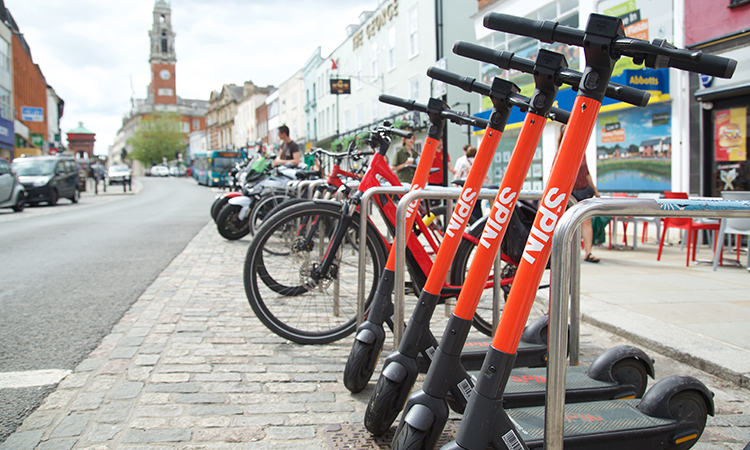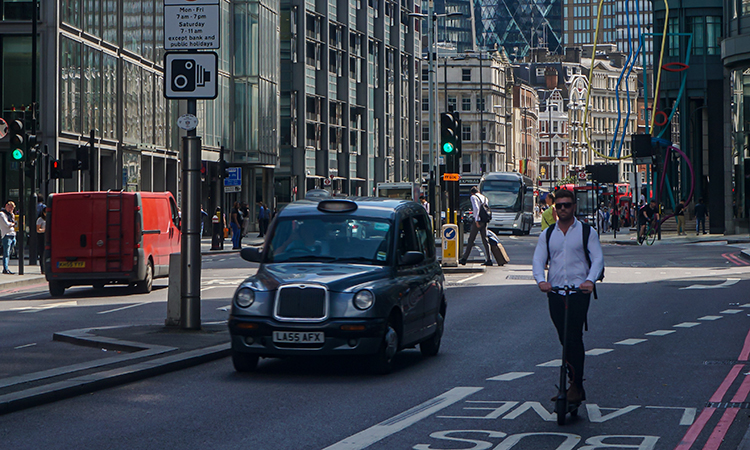The rise of the e-scooter: How micro-mobility is blooming
- Like
- Digg
- Del
- Tumblr
- VKontakte
- Buffer
- Love This
- Odnoklassniki
- Meneame
- Blogger
- Amazon
- Yahoo Mail
- Gmail
- AOL
- Newsvine
- HackerNews
- Evernote
- MySpace
- Mail.ru
- Viadeo
- Line
- Comments
- Yummly
- SMS
- Viber
- Telegram
- Subscribe
- Skype
- Facebook Messenger
- Kakao
- LiveJournal
- Yammer
- Edgar
- Fintel
- Mix
- Instapaper
- Copy Link
Posted: 25 October 2021 | Leah Hockley - Intelligent Transport, Steve Pyer - Spin | No comments yet
Steve Pyer, UK & Ireland Country Manager at Spin, sat down with Leah Hockley, Deputy Editor of Intelligent Transport, to consider the role of e-scooters in expanding the public transport offering, and discuss how their surging popularity has been accelerated by the pandemic.


Credit: Spin
Recently, the public transport industry has witnessed a significant rise in the popularity of e-scooters. What do you think are the reasons for this?
I think that there are several reasons for the rise in e-scooter popularity. One, obviously, is the COVID-19 situation, which has seen people less inclined to use public transport. To be able to use your own personal mode of transport, that is outdoors in the fresh air, does appeal to people, especially in the current climate.
The other reason for this popularity, I suppose, is that it’s all very new. This is the first new motor vehicle that’s been allowed on the UK’s roads for maybe a hundred years. And e-scooters are exciting, they’re really good fun! So, a lot of the popularity has been driven by fascination, excitement and the fact that they’re just a really good way of getting around your city.
How do you think the COVID-19 pandemic has impacted the public acceptance, and use, of e-scooters?
The reason that we’ve got such a widespread trial in place across the UK now is because of the pandemic. Before COVID-19, the Department for Transport (DfT) was already planning to conduct four trials with e-scooters in UK cities, because we’re behind the rest of the world in adopting these. But, when the pandemic came, the biggest fear from transport experts and planners was that people would start to go back to work, but shun public transport, and instead jump in a private car. City roads are always pretty gridlocked, and pollution levels are high. Obviously, if the amount of traffic increased, but still with the same infrastructure, there would be big problems.
To avoid this, quite a few measures were introduced. The DfT opened up e-scooter trials to any city that applied by the set deadline in August 2020. Cities were then given a specialty RO to allow them to use e-scooters on their roads. It’s a very defined trial area, with very defined trial outcomes, and only approved operators can be used.
There was also increased funding coming from the UK government for temporary cycle lanes, increasing cycling as a modal share. Cities like Leicester, for example, have invested heavily in closing down their bus networks, and putting in pop-up cycle lanes. A lot of those, I think, are here to stay. So, the pandemic has given the impetus to allow these trials to go ahead on a much wider scale than was previously envisioned.
Do you think that e-scooters are being considered more as an option to support people’s commutes as they return to the workplace?
I think they are. I worked in London cycle hire for seven years, where there was a very obvious tidal flow of peaks in the morning and evening rush hour. But, with e-scooters, since I joined Spin in September 2020, we see an afternoon peak, with most of our rides between 13:00 and 20:00.
Wouldn’t it be fantastic, if you turned up at a train station near where you work, and there’s an e-scooter there?”
However, we are already seeing a very slight shift, with a few more rides happening in the morning. It will be really interesting to see how commuter traffic changes, because I think that most people are still working at home, despite the easing of restrictions.
We’re talking to some of the councils that we work with, such as in Essex and Milton Keynes, about how we might be able to encourage people to use e-scooters in the morning. This might be through pricing, perhaps through different deployment strategies, or such like.
Do you think that the e-scooter is key in ensuring that commuters, and travellers in general, return to public transport post-pandemic, rather than going back to a private car?
They’re not key. Being completely honest, not everyone’s going to want to get on an e-scooter. Some people love cycling, some hate cycling – and it’s the same with e-scooters. Some people are massively against them. But, we’re reaching nearly half a million riders at Spin, across all our markets, in less than a year. They’re massively popular amongst their peer group. And that’s not just what you would traditionally expect – we’ve actually got a considerable age demographic.
At one of the safety demonstrations we did in Essex recently, we had a lady there saying that she was desperate to try them. She told us her grandchildren were saying to her, “Please don’t get on these, Granny. It’s not really safe.” But she told us that she was determined to learn how to e-scoot, so she could e-scoot to her grandchildren, and say, “Look what Granny can do. I’m cool!”
To go back to your question, e-scooters are not essential, but they are one part of an essential tool. So, you can have e-bikes, you can have e-scooters, you can have ordinary push bikes, and this will appeal to a demographic that won’t use a bus. Equally, there will people who don’t know how to ride, or don’t want to ride, a bike. But they might jump on an e-scooter instead. The more options you have for people to connect to major transit, or just to do their commute of two or three miles, which might be too far to walk, the better. E-scooters are another important tool that cities can use to support the door-to-door journey, and to encourage people not to just jump back in their car.
The ideal situation, then, is that people would travel by train, for instance, to a destination, and then jump on an e-scooter to get to where they want to be. Would you agree?
I do. The big buzzword at the moment is ‘mobility options’. Wouldn’t it be fantastic, if you turned up at a train station near where you work, and there’s an e-scooter there. If you’ve got a short journey, or just a little backpack, for there to be a bike. If you’ve got further to go, or if you want to carry a bit more luggage, for it to have a basket. Or, if it’s heaving down with rain and you’re taking your kids to school, for there to be a small car there for your short journey. Wouldn’t it be great to provide people with the opportunity to arrive at a mobility hub and choose from a wide variety of eco-friendly options which suits them, rather than just taking their private car because they can. That would be fantastic.


Pyer wants to see e-scooters approved for use across London, rather than select boroughs.
Transport for London (TfL) recently announced that their e-scooter trial, taking place in some of the boroughs, has been extended. Do you think that e-scooters should be adopted in more towns and cities?
They’re actually quite widespread already, with e-scooters in many towns and cities.
I think in London, specifically, I would love to see a pan-London operation. There are 32 boroughs in the city of London. Yet, one side of the street could be Lambeth, and the other could be Camden. But, you only know by looking at the road sign, and this can be confusing and frustrating for the rider, when trials are only in selected boroughs. I’d love to see London as one big trial – that would help consumers massively.
The latest data from the DfT shows there’s been over three and a half, maybe four million journeys since e-scooter operation started in August 2020. It’s clear that there is a benefit.
Not everybody can afford a car, not everybody wants a car, and we really don’t want everyone using cars, so they are beneficial. We’ve received stories from NHS staff – who ride for free via our Everyday Heroes programme – saying that they are using e-scooters to get to work. We hear from people saying how amazing it is for them to be able to get to work, or travel around the city, without their car. We give job seekers half-price access to the scheme, whilst they’re looking for work.
In London, specifically, I would love to see a pan-London operation”
I think that they can be a part of a very good integrated transport system in every city. Like I say, they are for a certain demographic of people, but the more options that you have, the better. So, as part of an integrated transport system, I think that e-scooters are really essential to have.
What plans does Spin have for the future?
Spin have just announced our ‘15 Minute City’ initiative. The concept is that you can do whatever you need, within 15 minutes. You can go to a supermarket. You can take your kids to school. You can access recreation facilities. You don’t have to drive an hour across the city, to get to your local shop. We want to work with cities to achieve this. We’re asking, how can Spin help cities to become a ’15 Minute City’?
As an organisation, we’re trying to go carbon neutral, as well. In the UK, we now have fully electric distribution vehicles. If you look at some schemes, like London, they still use diesel vans to deliver and transport their e-bikes, e-scooters and so on, across the city. Instead, we’ve developed the EAV 2Charge e-cargo bike. This is an enclosed, four-wheeled e-cargo-bike that’s got space for our batteries, as well as three scooters in the back.
We’re trialing different tools, but all of our distribution vehicles are now electric. Also, all of our electric charging comes from Octopus Energy, which is 100 per cent renewable. In the UK, Spin, as a company, is a lot newer, a lot younger, a lot more agile. We’re already carbon zero – and that’s how all micro-mobility should be. We can’t claim to have eco-friendly vehicles, and then fail in our supply chain.


Related topics
Accessibility, Alternative Power, COVID-19, Fleet Management & Maintenance, Mobility Services, On-Demand Transport, Passenger Experience, Public Transport, Sustainable Urban Transport, Transport Governance & Policy
Related modes
Bikes & Scooters
Related cities
London, United Kingdom
Related organisations
Department for Transport (DfT), Octopus Energy, Spin, UK Government
Related people
Steve Pyer








